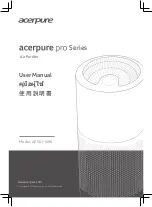
GB-26
WT07281X03
・
When expanding the on-site piping, satisfy the minimum insertion depth requirement as follows.
Pipe size [mm (in)]
Minimum insertion depth [mm (in)]
ø5 (ø1/4) or more, less than ø8 (ø13/8)
6 (1/4)
ø8 (ø13/8) or more, less than ø12 (ø1/2)
7 (5/16)
ø12 (ø1/2) or more, less than ø16 (ø11/16)
8 (3/8)
ø16 (ø11/16) or more, less than ø25 (ø1)
10 (7/16)
ø25 (ø1) or more, less than ø35 (ø1-7/16)
12 (1/2)
ø35 (ø1-7/16) or more, less than ø45 (ø1-13/16)
14 (9/16)
9-5-3. Sealing the openings around the pipes
Seal all openings around pipes and wires to keep out small animals, rainwater, or snow.
-Failure to do so may result in current leakage, electric shock, or damage to the unit.
Ⓐ
Ⓑ
Ⓐ
Example of closure materials (not supplied)
Ⓑ
Fill the openings
9-6. Air-tightness test
Do not use oxygen, flammable gas, or a refrigerant containing chlorine for air-tightness
testing.
-Doing so may result in an explosion. Chlorine will deteriorate the refrigerant oil.
After refrigerant pipe installation is completed, check the system for leaks by conducting an air-tightness test. If there
is a leak, the composition of the refrigerant will change and the performance will drop.
<Air-tightness test procedures>
①
Make sure the service valves are closed.
②
Add pressure to the refrigerant pipes through the service ports of the liquid and gas pipes.
* Pressurize to the design pressure (4.15 MPa) using nitrogen gas.
③
If the pressure holds for one day and does not decrease, the pipes have passed the test and there are no leaks.
If the pressure decreases, there is a leak. Look for the source of the leak by spraying a bubbling agent (e.g.,
Gupoflex) on the flared or brazed sections.
④
Wipe off the bubbling agent.
LO
HI
Ⓐ
Ⓓ
Ⓔ
Ⓒ
Ⓑ
Ⓑ
Ⓗ
Ⓘ
Ⓙ
Ⓖ
Ⓕ
Ⓐ
Nitrogen gas
Ⓑ
To indoor unit
Ⓒ
Gauge manifold
Ⓓ
Low pressure knob
Ⓔ
High pressure knob
Ⓕ
Service valve
Ⓖ
Liquid piping
Ⓗ
Gas piping
Ⓘ
Outdoor unit
Ⓙ
Service port
Содержание CITY MULTI PUHY-EP1000YSLM-A
Страница 2: ......
Страница 52: ...GB 50 WT07281X03 ...
















































